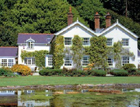Fruits and Follies of the Vineyard
Formerly part of the vast Hawkstone estate, this house is nestled among unique 18th-century landscapes


In 1774, having clambered over the dramatic crags and precipices of Hawkstone Park in north Shropshire, a somewhat breathless Dr Johnson (then aged 65) described the landscape as ?abounding with striking scenes and terrifick grandeur?. Country Life (July 3, 1958) compares its spectacular rock formations to ?one of the backgrounds in early Flemish paintings of St Jerome in the Wilderness?. In the 1960s, the writer James Stevenson describes this extraordinary place?part natural, part man-made?as ?eccentric, breathtaking and fun?.
Since medieval times, Hawkstone had been owned by the Hills, an entrepreneurial family with a talent for ?lucrative arithmetick?, whose members spent more than 150 years (from the early 1700s to the late 1800s) and vast sums of money building and adorning their Georgian mansion and its surrounding parkland. By 1756, Sir Rowland Hill had added the adjoining Red Castle Hill, former seat of the Audleys, to his domain, which, by 1795, included substantial buildings, such as the Obelisk, the White Tower, the Citadel, the Windmill, and the fortified Vineyard. When Dr Johnson remarked on the lack of a water feature at Hawkstone, Sir Rowland?s heir, Sir Richard Hill, created the two-and-a-half-mile Hawk Lake, ?by which means all the industrious poor in the neighbourhood were furnished with bread?.
Successive baronets carried on at Hawkstone in similar extravagant vein, but, by the early 1900s, the family fortune ran out, and the mansion and its estate had to be sold. The house was bought by the Order of the Redemptionists in 1926, and the rest of the estate divided up and sold off, part of it becoming a golf course and hotel. The follies and grottoes gradually fell into disrepair, or became overgrown.
On the break-up of the estate by Lord Marchamley in 1925, the early-18th-century Vineyard at Weston-under-Red Castle was sold off, along with its terrace, folly and bits of Rake Park, a former deer park. With Hawkstone Hall to the north, the Grade I-listed Follies parkland to the west, the Bury Walls Camp?s iron-age fort to the south, and the gardens of Hodnet Hall to the east, its setting is unique, and the reason why successive owners have cherished it over the years.
The Vineyard?s present owners, Prof Rolland Munro and his wife, Joanna, fell under its spell when it last came on the market some 12 years ago. They have gently upgraded the house, which now has four reception rooms, a large modern kitchen, a conservatory, five bedrooms and three bathrooms. Gradually, they have reclaimed the gardens?notably the Terrace where the Hills once grew exotic fruit and vines?and replaced the house in the midst of its original 30-acre mini-estate by buying in various parcels of adjoining farmland. But now they are moving, and The Vineyard is on the market through Lane Fox (01743 353511) at a guide price of £1.2 million.
This article first appeared in Country Life magazine on February 9, 2006.


For more on property, architecture, the arts and the countryside subscribe to Country Life magazine
Sign up for the Country Life Newsletter
Exquisite houses, the beauty of Nature, and how to get the most from your life, straight to your inbox.

Contact us about this story

Search all online stories

For what's in the magazine this week see contents

Sign up for our free newsletter

Country Life is unlike any other magazine: the only glossy weekly on the newsstand and the only magazine that has been guest-edited by HRH The King not once, but twice. It is a celebration of modern rural life and all its diverse joys and pleasures — that was first published in Queen Victoria's Diamond Jubilee year. Our eclectic mixture of witty and informative content — from the most up-to-date property news and commentary and a coveted glimpse inside some of the UK's best houses and gardens, to gardening, the arts and interior design, written by experts in their field — still cannot be found in print or online, anywhere else.
-
 Some of the finest landscapes in the North of England with a 12-bedroom home attached
Some of the finest landscapes in the North of England with a 12-bedroom home attachedUpper House in Derbyshire shows why the Kinder landscape was worth fighting for.
By James Fisher
-
 The Great Gatsby, pugs and the Mitford sisters: Country Life Quiz of the Day, April 16, 2025
The Great Gatsby, pugs and the Mitford sisters: Country Life Quiz of the Day, April 16, 2025Wednesday's quiz tests your knowledge on literature, National Parks and weird body parts.
By Rosie Paterson